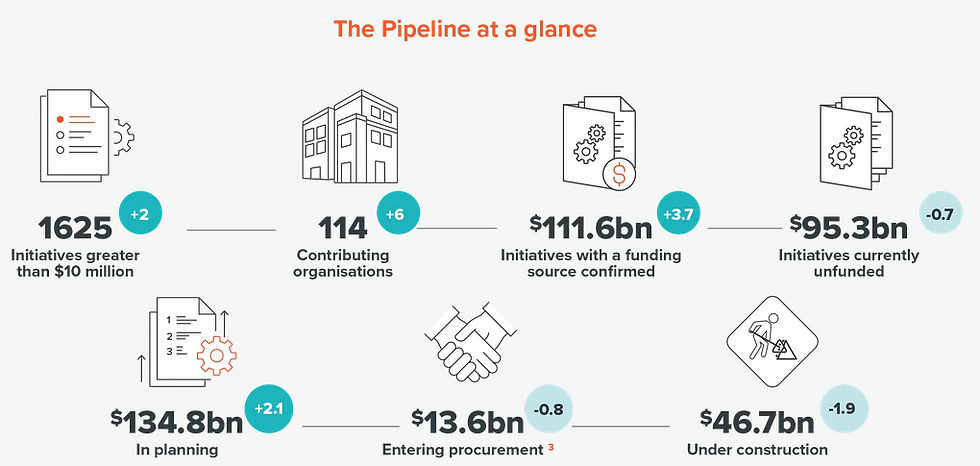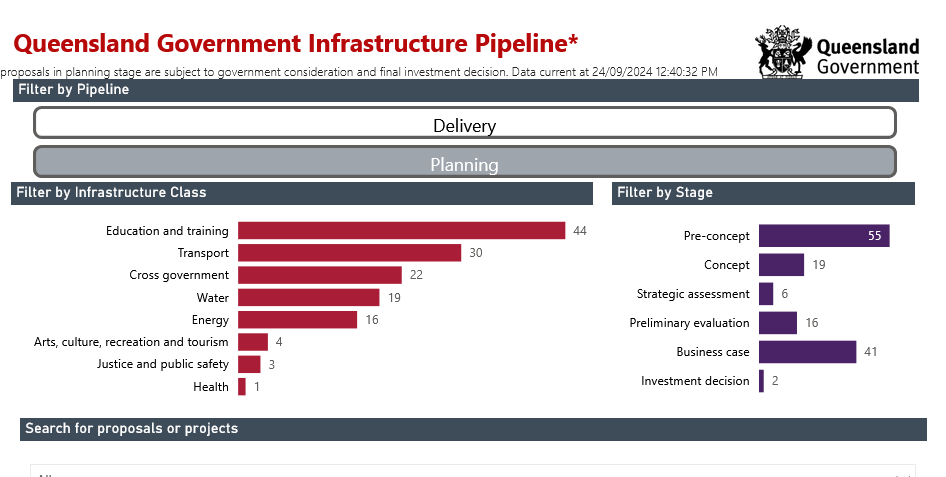Why Infrastructure Pipelines Are Essential for Long-Term Planning
- StratPlanTeam

- Aug 3
- 4 min read

Building for the Future Starts with a Clear Plan
Strong, sustainable infrastructure doesn't happen by accident. It starts with smart planning, reliable forecasting, and well-structured investment pathways. One of the most powerful tools governments and industries can use for this is the infrastructure pipeline. Infrastructure pipelines provide a long-term view of upcoming projects, helping governments, investors, and industry to plan ahead, allocate resources effectively, and drive economic growth.
This article explores the different types of infrastructure pipelines, why they are vital, and how they support better planning and delivery across the globe. It also includes examples from the UK, New Zealand, and Queensland, Australia, and finishes with practical recommendations for decision-makers.
What Is an Infrastructure Pipeline?
An infrastructure pipeline is a forward-looking tool that shows credible or expected investment plans for infrastructure projects over a set time period. It usually includes information such as funding sources, expected completion dates, procurement stages, and investment types.
Pipelines can differ in focus and format. For example:
Investment Programmes show planned government investment commitments across sectors.
Forward Pipelines track future projects from early planning through to delivery.
Priority Lists provide early-stage project suggestions before final approvals.
Project Trackers offer historic data on completed or ongoing projects.
Some countries also publish Public-Private Partnership (PPP) pipelines to help attract private investment in public infrastructure.

Types of Infrastructure Pipelines Explained
Understanding the types of pipelines helps stakeholders navigate the project landscape:
1. Investment Programmes
These identify committed public spending on infrastructure before the projects are fully developed. They show government priorities and give the market an early signal of future demand.
2. Forward Pipelines
These are traditional pipelines that track upcoming projects from planning to procurement. They are essential for businesses preparing for tenders and government agencies coordinating delivery.
3. Priority Lists
These are 'wish lists' of recommended infrastructure projects, often created to stimulate discussion or shape future funding strategies.
4. Project Trackers
These follow infrastructure deals from financial close to completion. They often focus on private sector involvement and track spending, timelines, and delivery performance.
Why Infrastructure Pipelines Matter for Long-Term Planning
For Governments
Pipelines are a central part of good infrastructure planning. They give departments visibility over what’s coming, enabling better coordination, resource management, and sequencing of projects. Pipelines also increase transparency and support public trust.
For Industry and Investors
Companies and investors rely on pipelines to assess market opportunities, plan their workforce, invest in new equipment, and track procurement timelines. This certainty reduces risk and encourages innovation, training, and efficiency.
For Communities
Citizens want to know what’s being built and when. Pipelines help communities see the value of public investment and provide a way to monitor progress and hold decision-makers accountable.
Case Study: New Zealand’s National Infrastructure Pipeline
Te Waihanga, the New Zealand Infrastructure Commission, developed a national infrastructure pipeline to improve coordination across sectors. Its main goals are:
Greater transparency: A reliable, up-to-date list of infrastructure projects from across the country.
Better coordination: Helping governments, councils, and industries align their planning.
Informed decision-making: Supporting the selection and timing of projects.
Stable workloads: Giving construction and engineering sectors a clear view of future work.
New Zealand’s pipeline includes both delivery-ready and early-stage proposals. The tool helps overcome the challenges of a fragmented infrastructure system with limited workforce and funding.

Case Study: Queensland’s Infrastructure Pipeline
Queensland’s government provides a state-level pipeline covering current and future projects. It includes:
Infrastructure delivery pipeline: Details projects underway or starting in the next four years.
Infrastructure planning pipeline: Lists proposals under development but not yet confirmed.
This makes it easier for suppliers and industry to plan ahead and support delivery. It also strengthens government decision-making and public engagement.

Case Study: The UK’s 10-Year Infrastructure Pipeline
The UK government’s pipeline looks 10 years ahead and includes public infrastructure and regulated private-sector projects in energy and water. It helps the construction sector respond to demand with better investment in training, innovation, and equipment.
However, to fully benefit from this pipeline, the UK must:
Stick to planned budgets and timelines.
Provide clear commercial models to attract private investment.
Improve data accuracy and update information regularly.
The UK pipeline is a starting point for a longer-term strategy that boosts productivity, attracts investment, and supports national goals.
Global Infrastructure Pipelines: GI Hub’s Pipeline Access
The Global Infrastructure Hub (GI Hub) has created Pipeline Access, a directory that compiles major infrastructure pipelines from G20 countries and beyond. This tool helps users compare investment trends and understand infrastructure delivery across different regions.
According to GI Hub:
88% of G20 countries have a Forward Pipeline, Priority List, or Project Tracker.
72% use an Investment Programme.
52% have a Project Tracker.
36% publish a Priority List.
This international comparison shows how common and useful infrastructure pipelines are becoming worldwide.
Recommendations for Governments and Policymakers
To maximise the impact of infrastructure pipelines, we recommend the following:
Develop a long-term view: Pipelines should look ahead at least 5–10 years.
Update regularly: Timely updates ensure pipelines remain useful and credible.
Engage the private sector: Clear signals help attract investment and build confidence.
Be transparent: Share project data openly to support public trust and industry planning.
Integrate across sectors: Pipelines should combine projects from transport, energy, housing, health, and digital infrastructure.
Invest in data quality: High-quality information supports better analysis and planning.
Pipelines Shape the Future
Infrastructure pipelines are much more than spreadsheets or dashboards—they are planning tools that help shape a country’s future. Whether it’s delivering better roads, schools, hospitals, or digital services, pipelines provide the visibility, certainty, and confidence needed for long-term infrastructure success.
As global demand for resilient infrastructure grows, countries that invest in well-designed, transparent, and up-to-date pipelines will be better prepared to deliver projects that meet their future needs.
For more insights on infrastructure, investment, and strategic planning, subscribe to our latest articles at www.Georgejamesconsulting.com.






Comments